Knowledge & Valuation Assignment: FINC19011 Business Finance
VerifiedAdded on 2023/01/03
|7
|1312
|77
Homework Assignment
AI Summary
This document presents a comprehensive solution to a business finance assignment. It begins with a reflective discussion on systematic risks, exploring their sources and impact on investment portfolios. The assignment then delves into general math questions, including probability calculations and the determination of intrinsic value using the dividend growth model. A case study examines savings growth and loan amortization, providing detailed calculations for future value, loan amounts, and annual repayments. The solution includes all the necessary formulas, calculation steps, and references, offering a complete and accurate response to the assignment's requirements. The assignment covers key concepts like systematic and unsystematic risks, intrinsic value calculations, and loan amortization schedules. The document is well-structured, providing clear explanations and calculations for each section of the assignment.
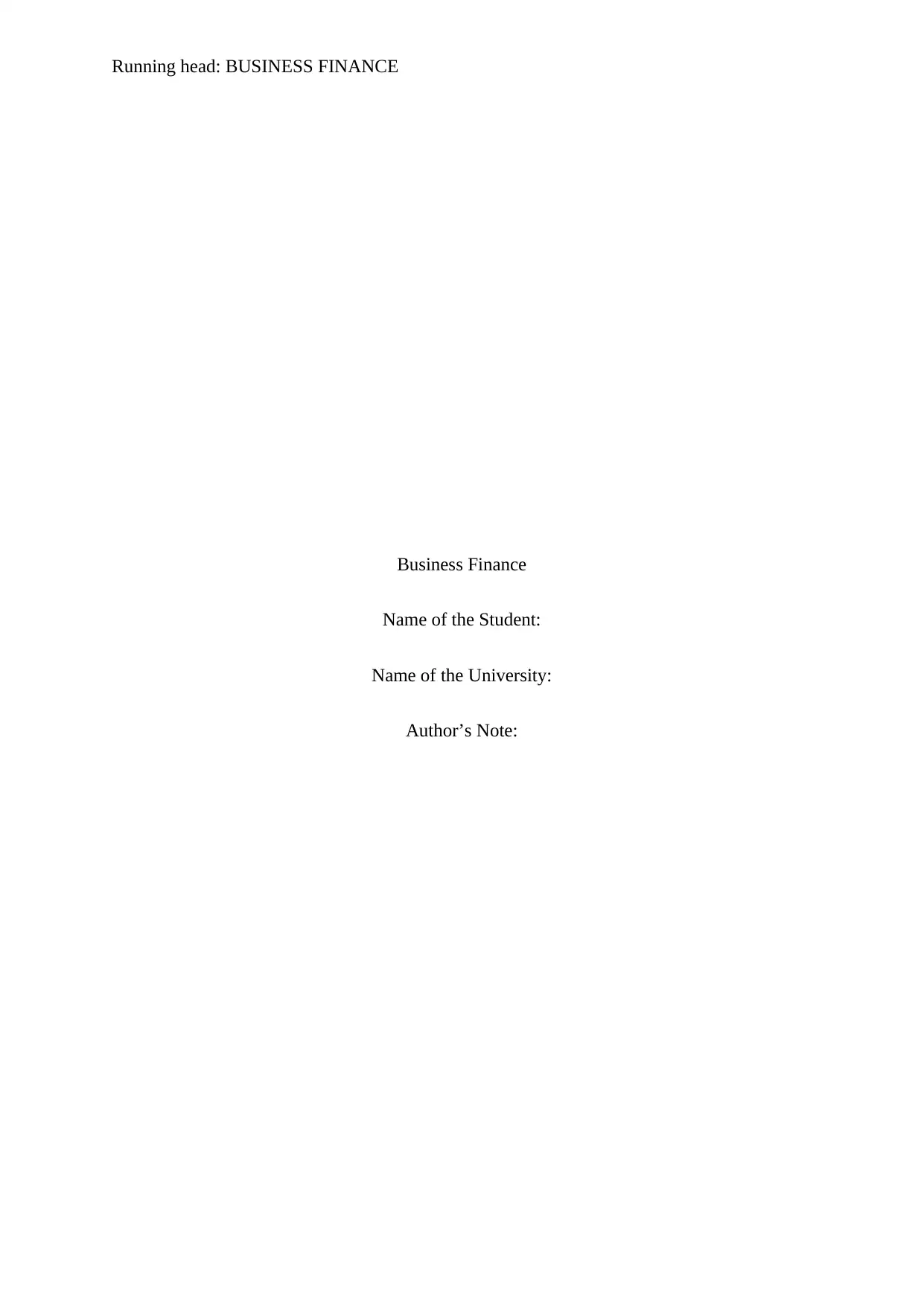
Running head: BUSINESS FINANCE
Business Finance
Name of the Student:
Name of the University:
Author’s Note:
Business Finance
Name of the Student:
Name of the University:
Author’s Note:
Paraphrase This Document
Need a fresh take? Get an instant paraphrase of this document with our AI Paraphraser
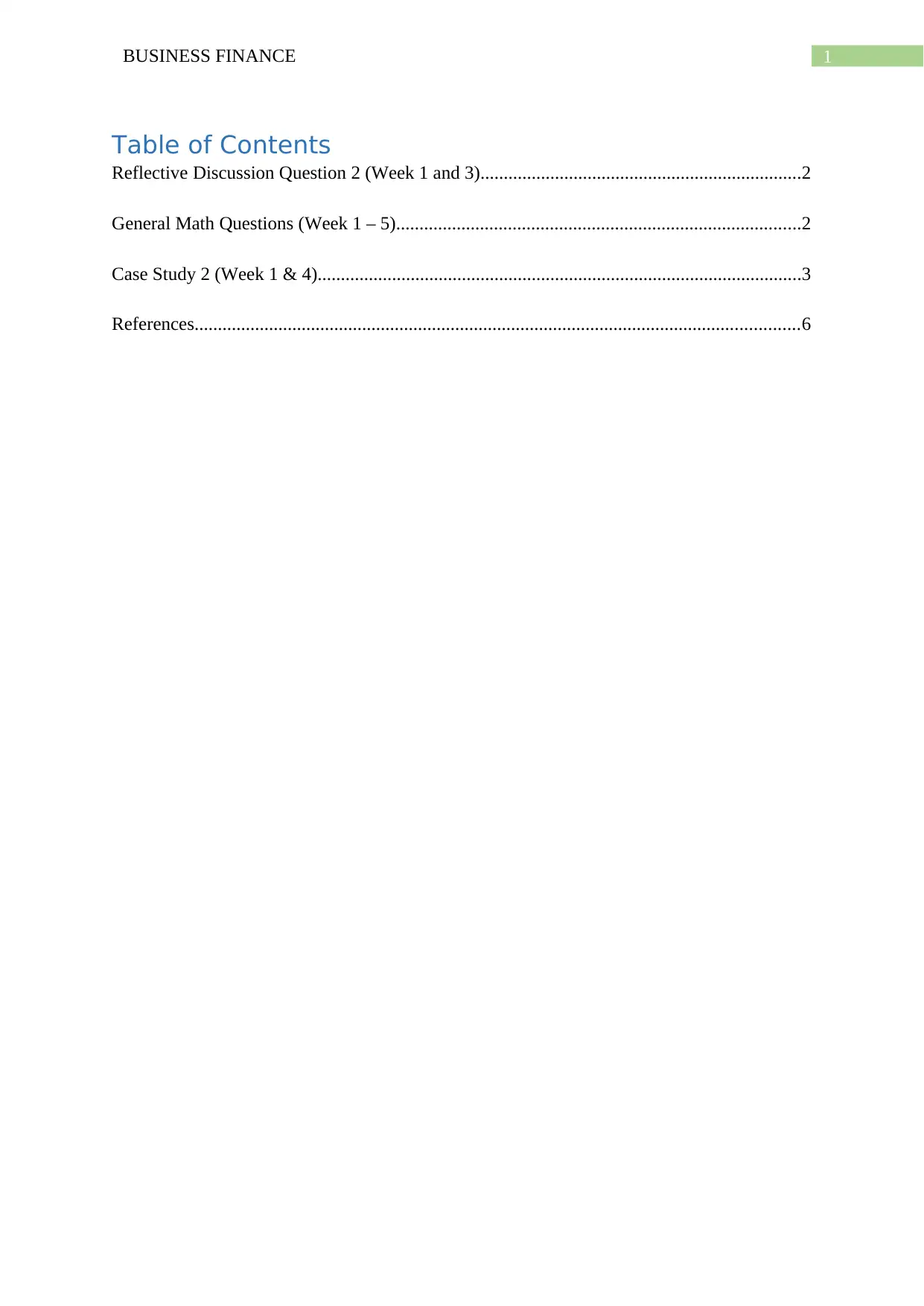
1BUSINESS FINANCE
Table of Contents
Reflective Discussion Question 2 (Week 1 and 3).....................................................................2
General Math Questions (Week 1 – 5).......................................................................................2
Case Study 2 (Week 1 & 4)........................................................................................................3
References..................................................................................................................................6
Table of Contents
Reflective Discussion Question 2 (Week 1 and 3).....................................................................2
General Math Questions (Week 1 – 5).......................................................................................2
Case Study 2 (Week 1 & 4)........................................................................................................3
References..................................................................................................................................6
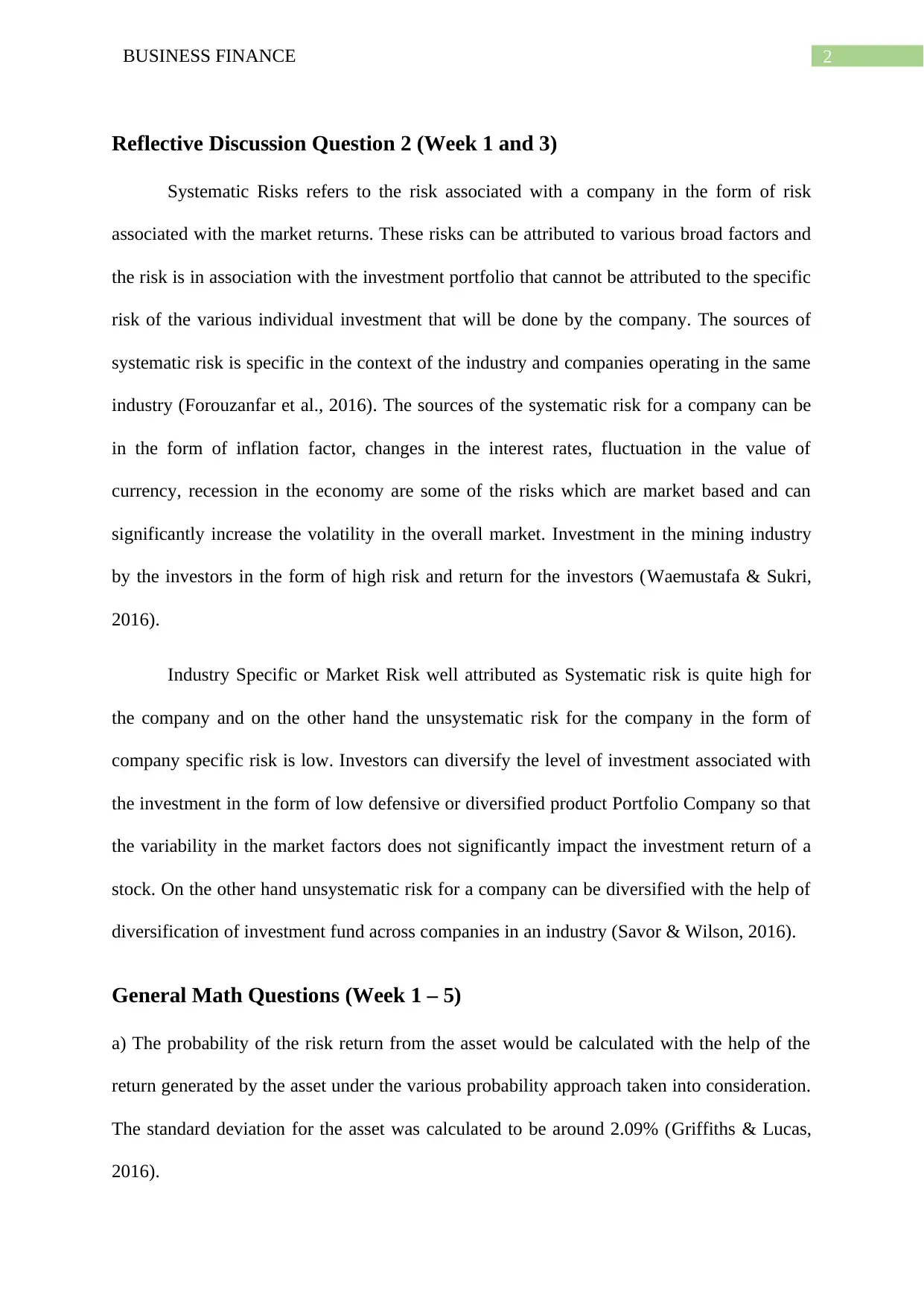
2BUSINESS FINANCE
Reflective Discussion Question 2 (Week 1 and 3)
Systematic Risks refers to the risk associated with a company in the form of risk
associated with the market returns. These risks can be attributed to various broad factors and
the risk is in association with the investment portfolio that cannot be attributed to the specific
risk of the various individual investment that will be done by the company. The sources of
systematic risk is specific in the context of the industry and companies operating in the same
industry (Forouzanfar et al., 2016). The sources of the systematic risk for a company can be
in the form of inflation factor, changes in the interest rates, fluctuation in the value of
currency, recession in the economy are some of the risks which are market based and can
significantly increase the volatility in the overall market. Investment in the mining industry
by the investors in the form of high risk and return for the investors (Waemustafa & Sukri,
2016).
Industry Specific or Market Risk well attributed as Systematic risk is quite high for
the company and on the other hand the unsystematic risk for the company in the form of
company specific risk is low. Investors can diversify the level of investment associated with
the investment in the form of low defensive or diversified product Portfolio Company so that
the variability in the market factors does not significantly impact the investment return of a
stock. On the other hand unsystematic risk for a company can be diversified with the help of
diversification of investment fund across companies in an industry (Savor & Wilson, 2016).
General Math Questions (Week 1 – 5)
a) The probability of the risk return from the asset would be calculated with the help of the
return generated by the asset under the various probability approach taken into consideration.
The standard deviation for the asset was calculated to be around 2.09% (Griffiths & Lucas,
2016).
Reflective Discussion Question 2 (Week 1 and 3)
Systematic Risks refers to the risk associated with a company in the form of risk
associated with the market returns. These risks can be attributed to various broad factors and
the risk is in association with the investment portfolio that cannot be attributed to the specific
risk of the various individual investment that will be done by the company. The sources of
systematic risk is specific in the context of the industry and companies operating in the same
industry (Forouzanfar et al., 2016). The sources of the systematic risk for a company can be
in the form of inflation factor, changes in the interest rates, fluctuation in the value of
currency, recession in the economy are some of the risks which are market based and can
significantly increase the volatility in the overall market. Investment in the mining industry
by the investors in the form of high risk and return for the investors (Waemustafa & Sukri,
2016).
Industry Specific or Market Risk well attributed as Systematic risk is quite high for
the company and on the other hand the unsystematic risk for the company in the form of
company specific risk is low. Investors can diversify the level of investment associated with
the investment in the form of low defensive or diversified product Portfolio Company so that
the variability in the market factors does not significantly impact the investment return of a
stock. On the other hand unsystematic risk for a company can be diversified with the help of
diversification of investment fund across companies in an industry (Savor & Wilson, 2016).
General Math Questions (Week 1 – 5)
a) The probability of the risk return from the asset would be calculated with the help of the
return generated by the asset under the various probability approach taken into consideration.
The standard deviation for the asset was calculated to be around 2.09% (Griffiths & Lucas,
2016).
⊘ This is a preview!⊘
Do you want full access?
Subscribe today to unlock all pages.

Trusted by 1+ million students worldwide
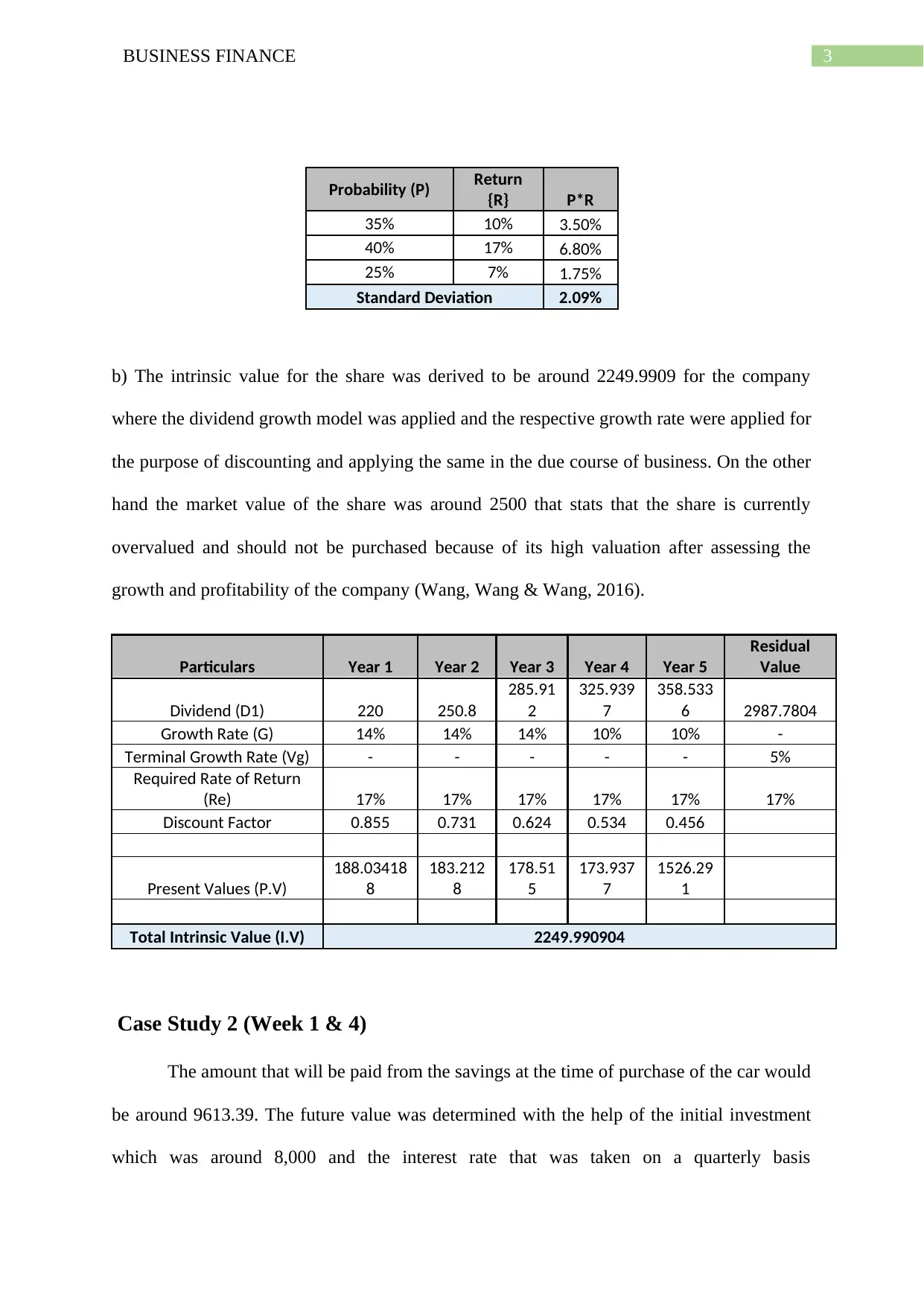
3BUSINESS FINANCE
Probability (P) Return
{R} P*R
35% 10% 3.50%
40% 17% 6.80%
25% 7% 1.75%
Standard Deviation 2.09%
b) The intrinsic value for the share was derived to be around 2249.9909 for the company
where the dividend growth model was applied and the respective growth rate were applied for
the purpose of discounting and applying the same in the due course of business. On the other
hand the market value of the share was around 2500 that stats that the share is currently
overvalued and should not be purchased because of its high valuation after assessing the
growth and profitability of the company (Wang, Wang & Wang, 2016).
Particulars Year 1 Year 2 Year 3 Year 4 Year 5
Residual
Value
Dividend (D1) 220 250.8
285.91
2
325.939
7
358.533
6 2987.7804
Growth Rate (G) 14% 14% 14% 10% 10% -
Terminal Growth Rate (Vg) - - - - - 5%
Required Rate of Return
(Re) 17% 17% 17% 17% 17% 17%
Discount Factor 0.855 0.731 0.624 0.534 0.456
Present Values (P.V)
188.03418
8
183.212
8
178.51
5
173.937
7
1526.29
1
Total Intrinsic Value (I.V) 2249.990904
Case Study 2 (Week 1 & 4)
The amount that will be paid from the savings at the time of purchase of the car would
be around 9613.39. The future value was determined with the help of the initial investment
which was around 8,000 and the interest rate that was taken on a quarterly basis
Probability (P) Return
{R} P*R
35% 10% 3.50%
40% 17% 6.80%
25% 7% 1.75%
Standard Deviation 2.09%
b) The intrinsic value for the share was derived to be around 2249.9909 for the company
where the dividend growth model was applied and the respective growth rate were applied for
the purpose of discounting and applying the same in the due course of business. On the other
hand the market value of the share was around 2500 that stats that the share is currently
overvalued and should not be purchased because of its high valuation after assessing the
growth and profitability of the company (Wang, Wang & Wang, 2016).
Particulars Year 1 Year 2 Year 3 Year 4 Year 5
Residual
Value
Dividend (D1) 220 250.8
285.91
2
325.939
7
358.533
6 2987.7804
Growth Rate (G) 14% 14% 14% 10% 10% -
Terminal Growth Rate (Vg) - - - - - 5%
Required Rate of Return
(Re) 17% 17% 17% 17% 17% 17%
Discount Factor 0.855 0.731 0.624 0.534 0.456
Present Values (P.V)
188.03418
8
183.212
8
178.51
5
173.937
7
1526.29
1
Total Intrinsic Value (I.V) 2249.990904
Case Study 2 (Week 1 & 4)
The amount that will be paid from the savings at the time of purchase of the car would
be around 9613.39. The future value was determined with the help of the initial investment
which was around 8,000 and the interest rate that was taken on a quarterly basis
Paraphrase This Document
Need a fresh take? Get an instant paraphrase of this document with our AI Paraphraser
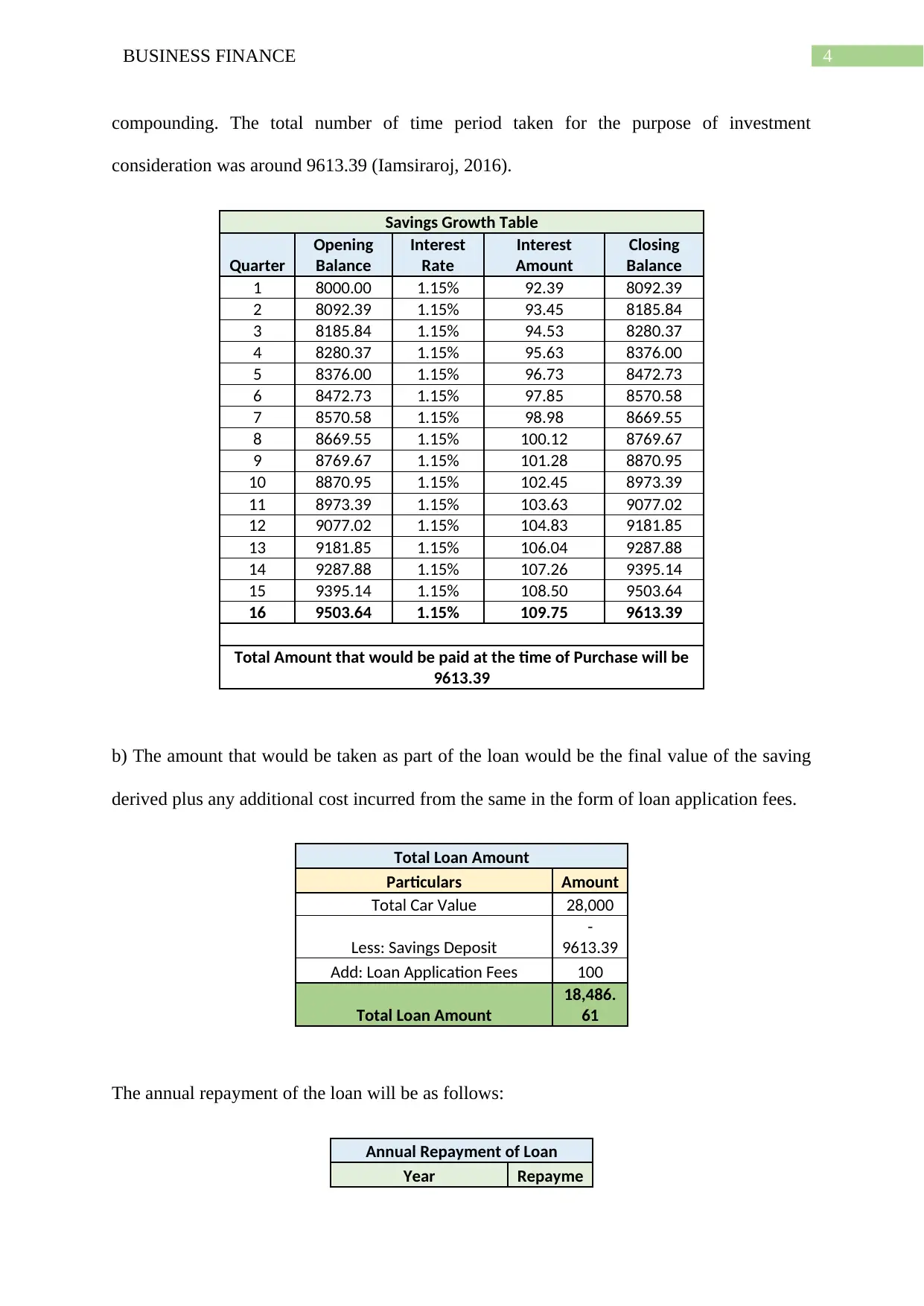
4BUSINESS FINANCE
compounding. The total number of time period taken for the purpose of investment
consideration was around 9613.39 (Iamsiraroj, 2016).
Savings Growth Table
Quarter
Opening
Balance
Interest
Rate
Interest
Amount
Closing
Balance
1 8000.00 1.15% 92.39 8092.39
2 8092.39 1.15% 93.45 8185.84
3 8185.84 1.15% 94.53 8280.37
4 8280.37 1.15% 95.63 8376.00
5 8376.00 1.15% 96.73 8472.73
6 8472.73 1.15% 97.85 8570.58
7 8570.58 1.15% 98.98 8669.55
8 8669.55 1.15% 100.12 8769.67
9 8769.67 1.15% 101.28 8870.95
10 8870.95 1.15% 102.45 8973.39
11 8973.39 1.15% 103.63 9077.02
12 9077.02 1.15% 104.83 9181.85
13 9181.85 1.15% 106.04 9287.88
14 9287.88 1.15% 107.26 9395.14
15 9395.14 1.15% 108.50 9503.64
16 9503.64 1.15% 109.75 9613.39
Total Amount that would be paid at the time of Purchase will be
9613.39
b) The amount that would be taken as part of the loan would be the final value of the saving
derived plus any additional cost incurred from the same in the form of loan application fees.
Total Loan Amount
Particulars Amount
Total Car Value 28,000
Less: Savings Deposit
-
9613.39
Add: Loan Application Fees 100
Total Loan Amount
18,486.
61
The annual repayment of the loan will be as follows:
Annual Repayment of Loan
Year Repayme
compounding. The total number of time period taken for the purpose of investment
consideration was around 9613.39 (Iamsiraroj, 2016).
Savings Growth Table
Quarter
Opening
Balance
Interest
Rate
Interest
Amount
Closing
Balance
1 8000.00 1.15% 92.39 8092.39
2 8092.39 1.15% 93.45 8185.84
3 8185.84 1.15% 94.53 8280.37
4 8280.37 1.15% 95.63 8376.00
5 8376.00 1.15% 96.73 8472.73
6 8472.73 1.15% 97.85 8570.58
7 8570.58 1.15% 98.98 8669.55
8 8669.55 1.15% 100.12 8769.67
9 8769.67 1.15% 101.28 8870.95
10 8870.95 1.15% 102.45 8973.39
11 8973.39 1.15% 103.63 9077.02
12 9077.02 1.15% 104.83 9181.85
13 9181.85 1.15% 106.04 9287.88
14 9287.88 1.15% 107.26 9395.14
15 9395.14 1.15% 108.50 9503.64
16 9503.64 1.15% 109.75 9613.39
Total Amount that would be paid at the time of Purchase will be
9613.39
b) The amount that would be taken as part of the loan would be the final value of the saving
derived plus any additional cost incurred from the same in the form of loan application fees.
Total Loan Amount
Particulars Amount
Total Car Value 28,000
Less: Savings Deposit
-
9613.39
Add: Loan Application Fees 100
Total Loan Amount
18,486.
61
The annual repayment of the loan will be as follows:
Annual Repayment of Loan
Year Repayme
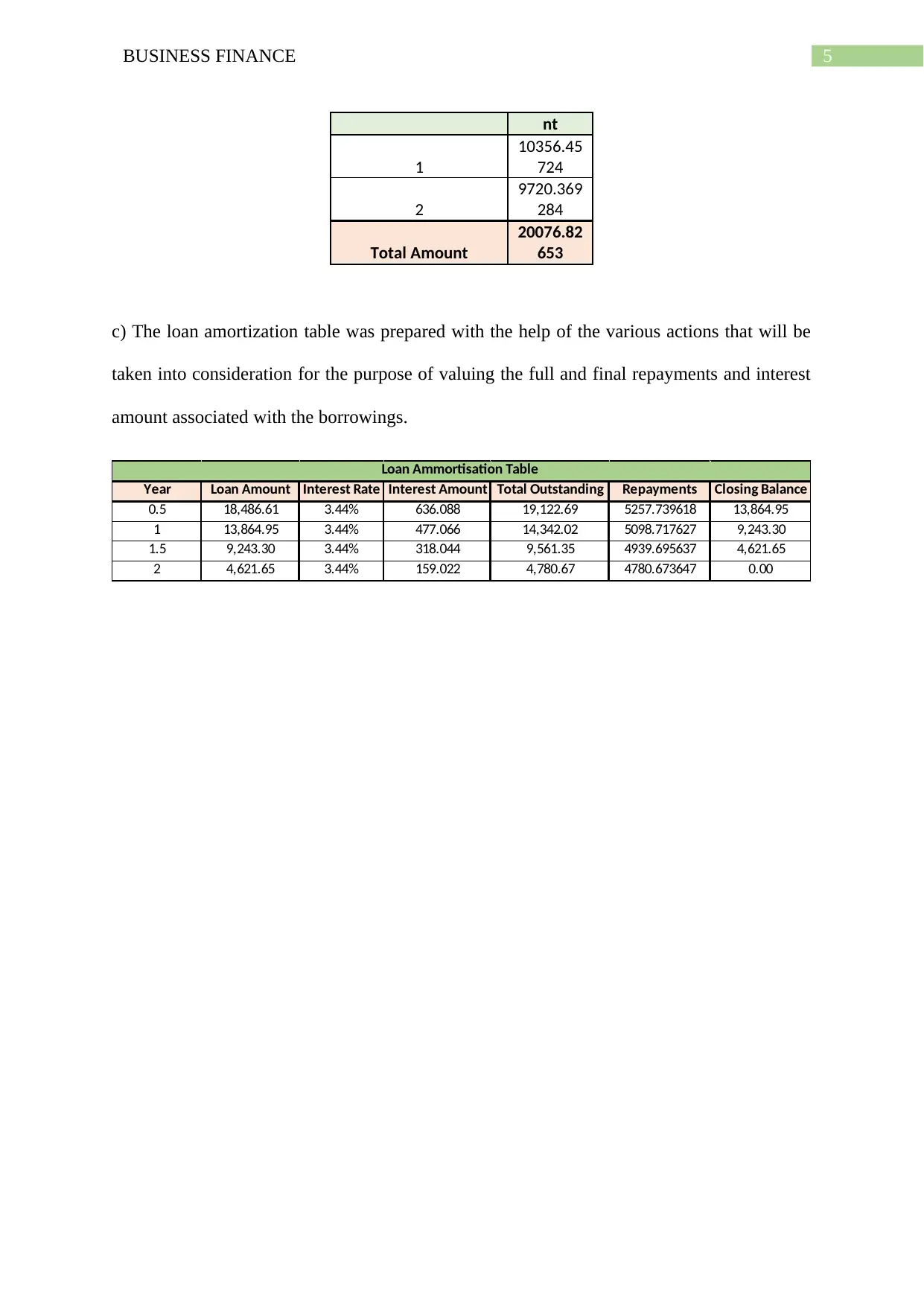
5BUSINESS FINANCE
nt
1
10356.45
724
2
9720.369
284
Total Amount
20076.82
653
c) The loan amortization table was prepared with the help of the various actions that will be
taken into consideration for the purpose of valuing the full and final repayments and interest
amount associated with the borrowings.
Year Loan Amount Interest Rate Interest Amount Total Outstanding Repayments Closing Balance
0.5 18,486.61 3.44% 636.088 19,122.69 5257.739618 13,864.95
1 13,864.95 3.44% 477.066 14,342.02 5098.717627 9,243.30
1.5 9,243.30 3.44% 318.044 9,561.35 4939.695637 4,621.65
2 4,621.65 3.44% 159.022 4,780.67 4780.673647 0.00
Loan Ammortisation Table
nt
1
10356.45
724
2
9720.369
284
Total Amount
20076.82
653
c) The loan amortization table was prepared with the help of the various actions that will be
taken into consideration for the purpose of valuing the full and final repayments and interest
amount associated with the borrowings.
Year Loan Amount Interest Rate Interest Amount Total Outstanding Repayments Closing Balance
0.5 18,486.61 3.44% 636.088 19,122.69 5257.739618 13,864.95
1 13,864.95 3.44% 477.066 14,342.02 5098.717627 9,243.30
1.5 9,243.30 3.44% 318.044 9,561.35 4939.695637 4,621.65
2 4,621.65 3.44% 159.022 4,780.67 4780.673647 0.00
Loan Ammortisation Table
⊘ This is a preview!⊘
Do you want full access?
Subscribe today to unlock all pages.

Trusted by 1+ million students worldwide
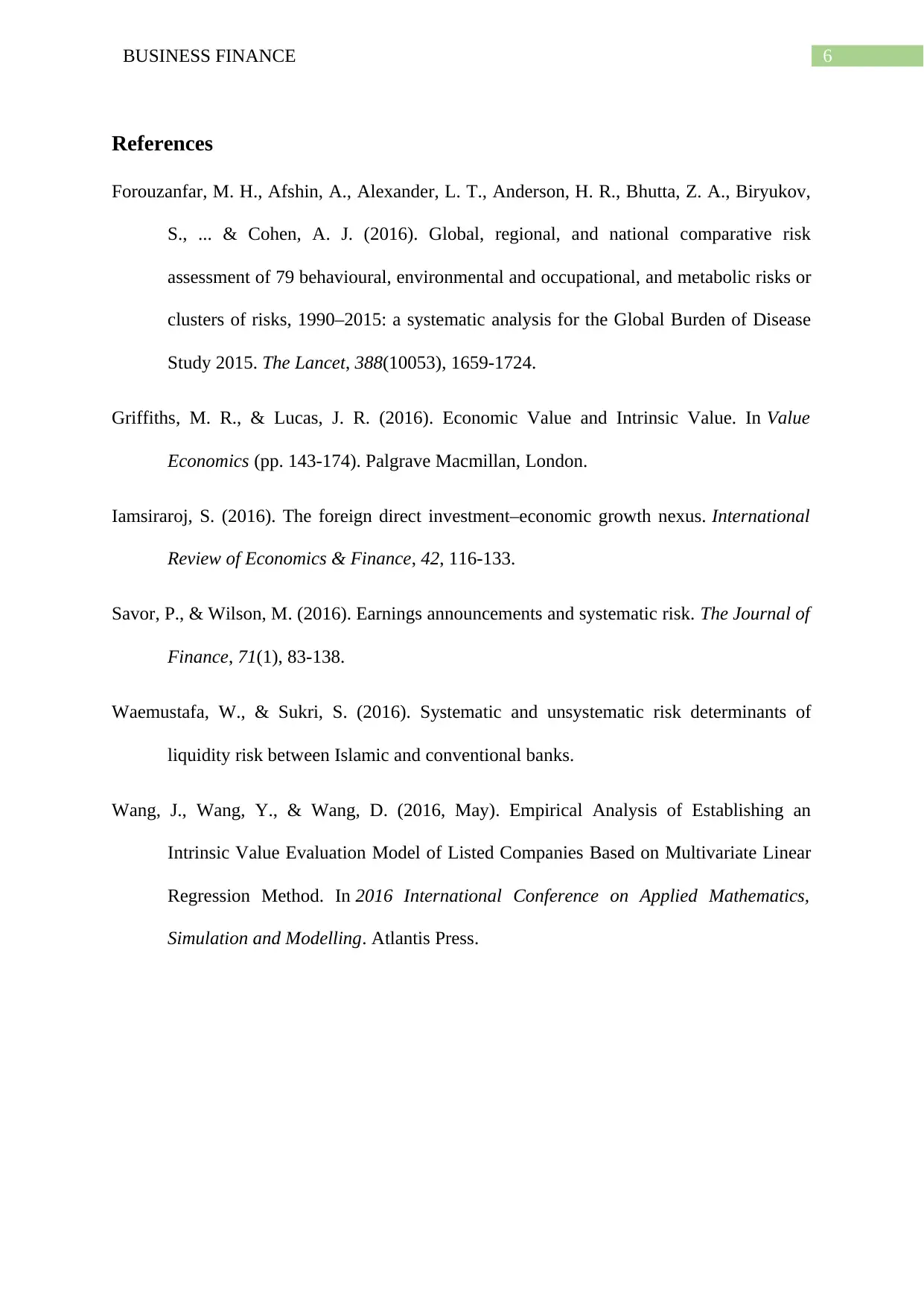
6BUSINESS FINANCE
References
Forouzanfar, M. H., Afshin, A., Alexander, L. T., Anderson, H. R., Bhutta, Z. A., Biryukov,
S., ... & Cohen, A. J. (2016). Global, regional, and national comparative risk
assessment of 79 behavioural, environmental and occupational, and metabolic risks or
clusters of risks, 1990–2015: a systematic analysis for the Global Burden of Disease
Study 2015. The Lancet, 388(10053), 1659-1724.
Griffiths, M. R., & Lucas, J. R. (2016). Economic Value and Intrinsic Value. In Value
Economics (pp. 143-174). Palgrave Macmillan, London.
Iamsiraroj, S. (2016). The foreign direct investment–economic growth nexus. International
Review of Economics & Finance, 42, 116-133.
Savor, P., & Wilson, M. (2016). Earnings announcements and systematic risk. The Journal of
Finance, 71(1), 83-138.
Waemustafa, W., & Sukri, S. (2016). Systematic and unsystematic risk determinants of
liquidity risk between Islamic and conventional banks.
Wang, J., Wang, Y., & Wang, D. (2016, May). Empirical Analysis of Establishing an
Intrinsic Value Evaluation Model of Listed Companies Based on Multivariate Linear
Regression Method. In 2016 International Conference on Applied Mathematics,
Simulation and Modelling. Atlantis Press.
References
Forouzanfar, M. H., Afshin, A., Alexander, L. T., Anderson, H. R., Bhutta, Z. A., Biryukov,
S., ... & Cohen, A. J. (2016). Global, regional, and national comparative risk
assessment of 79 behavioural, environmental and occupational, and metabolic risks or
clusters of risks, 1990–2015: a systematic analysis for the Global Burden of Disease
Study 2015. The Lancet, 388(10053), 1659-1724.
Griffiths, M. R., & Lucas, J. R. (2016). Economic Value and Intrinsic Value. In Value
Economics (pp. 143-174). Palgrave Macmillan, London.
Iamsiraroj, S. (2016). The foreign direct investment–economic growth nexus. International
Review of Economics & Finance, 42, 116-133.
Savor, P., & Wilson, M. (2016). Earnings announcements and systematic risk. The Journal of
Finance, 71(1), 83-138.
Waemustafa, W., & Sukri, S. (2016). Systematic and unsystematic risk determinants of
liquidity risk between Islamic and conventional banks.
Wang, J., Wang, Y., & Wang, D. (2016, May). Empirical Analysis of Establishing an
Intrinsic Value Evaluation Model of Listed Companies Based on Multivariate Linear
Regression Method. In 2016 International Conference on Applied Mathematics,
Simulation and Modelling. Atlantis Press.
1 out of 7
Related Documents
Your All-in-One AI-Powered Toolkit for Academic Success.
+13062052269
info@desklib.com
Available 24*7 on WhatsApp / Email
![[object Object]](/_next/static/media/star-bottom.7253800d.svg)
Unlock your academic potential
Copyright © 2020–2025 A2Z Services. All Rights Reserved. Developed and managed by ZUCOL.




